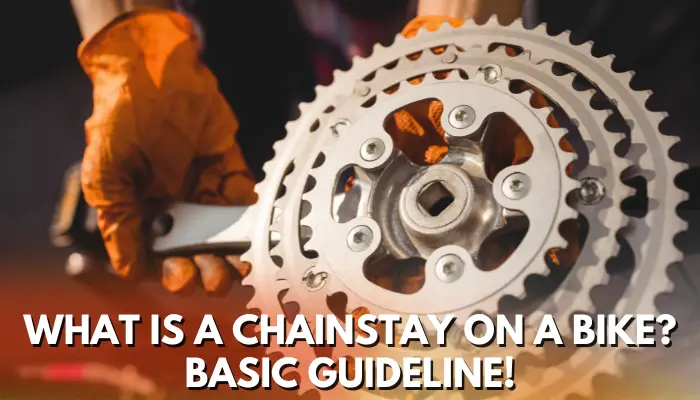What Is a Chainstay On a Bike? Basic Guideline!

Do you know that chainstay is an essential component of a bike? It aligns your bike and provides proper tension. Learn what is a chainstay is on a bike, and get to know its fundamentals.
What is a chainstay on a bike? It is a component of a bike frame, which comes in tube paring or structural form. Depending on your bike, it also comes in a shorter or longer chainstay. It is necessary to have the right size of the chain stay because if not, you can meet some minor incidents and get into trouble riding it.
This article will provide the importance and function of a chainstay on a bike.
Table of Contents
What Is a Chainstay On a Bike?
When it comes to what a chainstay on a bike? Every component is essential in its overall performance. Such a critical component is a chain stay. And interestingly, people often overlook it.
A chainstay links the bottom bracket and the rear axle, which means it connects the bottom bracket and the center of the back wheel; the rear axle is the slot where the back wheel goes in. The paramount importance of the bike is its stability and power to the ride quality of a bike.
What Is Chainstay Made of?
The material and construction of a chain stay based on steel, carbon fiber, titanium, etc.; interestingly, each material has specific uses. To gain the proper knowledge of what is a chainstay on a bike, have a look at the material of the chain stay;
Steel Chain Stay:
It is known for its comfort riding and durability so that a rider can have a better riding quality.
Aluminum Chain Stay:
It is light in weight and tight, and it provides enough energy transfer.
Carbon Fiber Chain Stay:
It is usually found in high-end performance bikes. It provides strength, damping vibration, and stiffness to the bike.
Titanium Chain Stay:
It provides balance to the bike. Maintain its durability, comfort, and weight. It is popular among all chain restaurants.
Which Material of Chain Stay Is Better?
Well, it depends on the bike you are planning to ride on. Your budget and your bike choice will decide it. Each material has its pros and cons, so it depends on you. What do you prefer the most?
Tubes of Chain Stay:
After the material of the chain stays, look at the chain stay tube; interestingly, they are not equally made.
- The chain stay tube isn’t equally made because the drive side is heavier than the chain side, and the other side of the chainstay is a bit lighter in weight, which involves increasing power efficiency.
Impact of the Chain Stays on Ride Quality:
- The main impact of the chainstay is its design and characteristics, which affect the quality of the ride.
- When it comes to stiffness, it helps in efficient energy transfer with the help of reducing energy loss. As a result, a more responsive ride.
- However, more vibration of the road can be felt by the rider
- Furthermore, the vibrating damping quality of a bike helps in decreasing the impact of the harsh road, which may take more power efficiency, which is worth taking.
Length of the Chain Stay:
It is the distance of the chain that stays between origins and ends. Meaning it measures the distance of the center of the bottom bracket to the rear wheel axle. The z-axle isn’t part of the measurement. Horizontal, sliding, and dropouts are part of the shortest length.
Why Is the ChainStay Length Important?
There are two types of chain stay length, long and short chain stay. And due to the significant impact of the chain stay, it is an essential aspect of the bike’s component. Handling the bike is necessary, and the chainstay length looks after it.
Impact of The Short Chainstays:
The main impact of shorter length is the balancing between the aggressive riding positions. Furthermore, it helps quicker handling by reducing the turning radius and the chain on the tire rub. It also impacts stiffness. It makes the stunts easier on the bike, like wheelies, bunny hops, and manuals.
However, the wheelbase is shorter and makes the bike less stable. Hence, the bike moves around effortlessly. And now the turnover rate is quicker. Due to the closeness to the center of gravity, a rider will feel like sitting on a rear wheel.
Riding an XC or trail bike can easily attain high speed, which is impossible with a longer chain. People who don’t want a heavy bike prefer to go with a light chain stay, which is a short chain stay. With short length, you need to be more professional in handling.
Impact of the Longer Length of Chain Stay:
It balances the upright position of the rider by providing stable handling. It also helps in providing a more comfortable ride by increasing compliance. Moreover, the extended chain stay of mountain bikes increases the wheelbase, which helps control and provide the proper balance at high speed.
In addition to protecting from bumpy roads, the wheelbase brings the rider close to the bike’s center and makes the bike smooth. Movability is also affected by the extended chain stay.
However, the heavyweight of the long chainstay bike does make your bike heavy in size, which is why people who prefer the lightweight bike don’t go for the extended chainstay bike. But for the harsh and challenging terrains, only the extended chain stay will help you get through it. At the same time, the rear wheel gives better handling on steep climbs.
Why do you Need a Chainstay Protector?
When you ride on challenging, muddy, or off-road tracks, the chainstay is most likely to get affected due to the contact of the bike chain damage to the paint of the chainstay. Similarly, the bike frame can get dirty due to the dirt thrown by the bike chain. And it isn’t easy to remove. Therefore, to protect the bike’s chain stay, you have a few options; look at them in detail.
The Protection of Chain Stay:
It is the simplest and yet most important accessory of the bike components. It helps to protect the chainstay from possible damage. The nearest component of the bike to the bike chain is the chain stay, whatever the bike chain brings from the riding terrain.
Getting a chain slapped can cause severe damage to the bike frame and paint chipping; that is why there are three types of chain stay protection which are as follows:
Types of Chainstay Protectors:
On the basis of various types of bikes, the chain stays protectors are designed according to them. It will better understand what is a chainstays on a bike and how you can protect it.
Neoprene ChainStay Protector:
Neoprene chainstay protectors are a form of neoprene that is considered a durable material, and it is used in the manufacturing of wetsuits. They usually use Velcro strips to install and remove neoprene protectors. They are considered good for the high protection of the chain stay.
Adhesive Rubber or Vinyl Chain Stay Protector:
They are sticky, so they stick directly on the chain; you don’t have to use any strip for that. They are lighter in weight, and they can’t be seen easily. Hardly visible so that the aesthetic sense of the bike remains the same. However, due to the lightweight nature of the protector, the heavy chain stay cannot easily get protected from it as neoprene protects the chain slap.
DIY ChainStay Protector:
There is another level of protection that is DIY by the rider itself. Some riders make their own using old tubes, durable fabric, and electrical tape. And it is cheaper than the other two protectors. But yes, the protection isn’t the same as the above two, but it doesn’t mean the DIY protector is useless.
If you get the exact size chainstay protector, don’t forget to secure it with a zip. So that it can stay in position, it’s better to have a DIY protector, which is more reasonable to buy.
Benefits of Protector:
People often neglect the protection of chain stay unless they ultimately damage it. So it’s better to use the protector before you destroy the bike frame. Few are the benefits that will help you to understand the need for protectors:
- Chainstay protectors not only bodyguard your bike but also have some additional benefits. The noise that is produced due to the chain slap can become noiseless and provide you with a peaceful ride. Unnecessary noise can become a big distraction if you are on a challenging track or performing a wheelie.
- The most crucial factor is that it doesn’t devalue your bike, which is expected if you don’t use a chain stay protector. If your bike paint is chipping or damaged, the frame will cause a low cost to your bike, whereas the chain stay protector will help keep it the same.
FAQs:
What Is the Chainstay Made for?
It is made for transferring the power to the pedaling motion to the rear wheel, providing the rider with a smooth and efficient riding style.
What Do You Know About Chainstay Guides?
A chainstay guide is a metal plate typically used on the rear hub instead of a chain ring. It keeps the alignment for cleaner shifting and minimizes the chain slap. As far as a conjunction is concerned, it protects the chain and ring from getting damaged by rocks and other possible objects.
What Do You Know About Chainstay Angles?
It is one of the aspects of frame geometry, and it is often neglected. Moreover, it is defined as the angle from the rear axle to the bottom bracket. To get a broad way of the chain stay angle, google the related articles.
Conclusion:
There is no doubt that chainstay is one of the most critical aspects of the bike, and it requires protection. Now whenever you plan to buy a new bike, consider all the components that should be in good condition and do some research yourself. Even if you go to sell your bike, you need to be aware of the chain stay.
Chain stay helps in the efficiency of the power transfer to the pedal.
You will better understand what is a chainstay on a bike and how to protect it. Now you also know the chain stay impacts every move you make on a pedal, so take care of chain stay appropriately by choosing the suitable protector.
